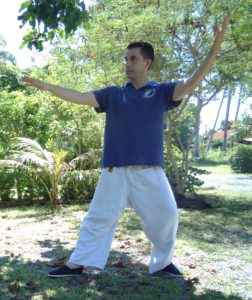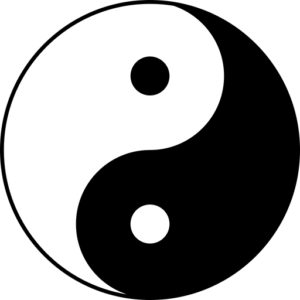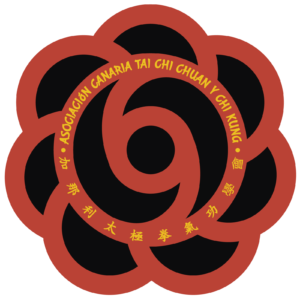Slanted FlyingJournal of Tai Chi Chuan
Training
Taiji Sword (劍 Jian)
Sword (劍 jian, double-edged straight sword) is perhaps the most popular weapon in Taijiquan (太極拳) practice, even though it is more difficult to use properly than the saber (刀 dao, sometimes called a “broadsword” and refers to the single edged sword), the other classical short weapon. This may be due to the circularity inherent in the way the jian is supposed to be used, like a flying phoenix or like a swimming dragon (both of which are said to move in spirals).
While made of metal, the jian has the quality of water when associated with the wuxing (五行 five phases), whereas the dao is associated with metal. The dao is more direct and uses many powerful techniques, whereas the jian is more fluid and yielding, and is more subtle and uses more agility and precision than the dao’s techniques (i.e., more finesse than power). The jian is said to be the “king” of short weapons, and is considered to be a master’s or gentleman’s weapon.
Unfortunately, many of the practice jian manufactured today have greatly altered characteristics from historic weapons, in order to make them easier to use in solo performance, resulting in modern swords that are typically handled improperly when compared to how historically accurate weapons are handled.
Historic swords needed a sufficient mass (typically 600-900 grams) to resist easy defensive deflections away from the intended target, and the point of balance needed to be far enough out beyond the handle and hand guard (typically 6-8 inches beyond where the handle meets the guard) to facilitate pivoting the weapon around an opponent’s weapon, as well as to resist deflections and help the sword to remain on target. The mass and point of balance of historic swords also helps one to properly control the opponent’s weapon when utilizing deflections and other techniques that occur when weapons contact each other.
Conversely for performance, with no consideration for combat functionality, one would want a sword that is as light as possible and with a point of balance closer to the hand. This would make the sword-like object easier (and faster) to move and would be able to be manipulated in a dramatic fashion with a mere flick of one’s wrist. These characteristics produced the floppy-bladed wushu (武术) performance jian that got so extreme that competition rules had to be made requiring the blade to be able to support the weight of the jian when balanced on its tip.
Unfortunately, the way that manufacturers met this requirement was to merely stiffen the spine of the blade without adding significant weight to the jian. These revised performance jian appear less comical, but the performers did not need to alter their habitual ways of handling the jian. The jian were used merely as stage props that allowed quick and flashy movements that looked impressive, but were without realistic function and would be wrong in combat. Wushu swordsmanship became merely dancing with stage props, however flashy and impressive that dancing was.
Training with unrealistic weapons generally leads to unrealistic movements for controlling the actions of the jian, and typically leads to a misunderstanding of the characteristics of the weapon and the movements and purpose of one’s forms.
A jian should have four points that one pivots around; the tip, at points about one third and about two thirds of the length of the blade, and the hand/wrist/root of the sword blade. Only the last is facilitated by a balance point close to the guard, but at the expense of the other three.
Pivoting around the tip is often used to maintain the weapon pointing towards the opponent while changing the angle of the potential attack. Pivoting around the point about a third of the blade length from the tip is often used to change from a thrust with the tip to a cut with the end third of the blade, as well as situations where light contact with the opponent’s weapon is used in order to exploit an opening to attack through. Pivoting around the point about two thirds of the blade length from the tip of the blade is frequently used when deflecting and controlling an opponent’s attack, and setting up a counterattack.
The pivot at the hand/wrist/blade root is where most of the potential problems occur, and is often where those using unrealistically light jian tend to move the most. Too often those using a light weapon flip their wrist around like they are using a flywhisk!
We do not want too firm of a grip such that the sword becomes primarily just an extension of the forearm (like when using a club or a bat), but we also do not want a too loose grip where the sword can be easily knocked off target or even knocked out of one’s grip. We want a mobile “joint” that is neither excessive nor deficient.
Different schools have slightly different recommendations regarding gripping the sword, but most have the thumb and index and/or middle fingers doing most of the gripping, with the ring and little fingers mainly aiding in controlling and directing the sword. The sword’s handle should be movable enough in one’s grip that it can break contact with the palm and/or heel of the hand, but one should still maintain sufficient control of the handle that an opponent cannot adversely affect one’s grip just by bumping into your sword.















To be clear for those discussing the sword/jian balance point, the important distance is from the hand to the point of balance [POB]. My article therefore states the POB distance from the hand side of the hand guard. Distance measured from the front (blade side) of the guard is much less accurate since many hand guard designs exist [e.g., the classic “ace-of-spades” guard, lion mask, bat…and even occasionally disk shaped guards like those commonly found on sabers/dao] and can affect the distance between the hand and the root of the blade (where the blade meets the guard) by several inches.
Well being rather new to the jian I found the article and the comments very informative.
I’ve been practicing the sword for around 5 years, and it really is, to me at least, the toughest to get to grips with.
Now that I have the basic sequence, I try to manoeuvre the jian using my body, just as in any of the weapons forms, and the form itself.
On reading the article and comments, I checked my own sword and I’m happy to find, the point of balance is 3 inches from the back of the guard.
I practice all my forms with the invisible opponent (s) in mind. It helps me to understand how to express the point of power, defence or control while keeping balanced throughout.
I have quite a few years of hand based combat experience, but not with weapons. I do believe that fighting knowledge helps with the non-weapons forms, and I believe that some decent sparring with weapons would be very beneficial in truly mastering the weapons forms. Pretty hard to come by in my neck of the woods 😁
I am considering buying a jian and this article is by far the most informative. I am looking at choosing the right sword for me and the correct form